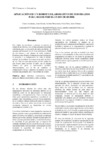| dc.contributor.author | Fernández, Garazi | |
| dc.contributor.author | Herrán, Asier | |
| dc.contributor.author | Mancisidor, Aitziber | |
| dc.contributor.author | Pérez, César | |
| dc.contributor.author | Cabanes, Itziar | |
| dc.date.accessioned | 2021-08-26T07:39:25Z | |
| dc.date.available | 2021-08-26T07:39:25Z | |
| dc.date.issued | 2021 | |
| dc.identifier.citation | Fernández, G., Herrán, A., Mancisidor, A., Pérez, C., Cabanes, I. Aplicación de un robot colaborativo de dos brazos para resolver el cubo de Rubik. En XLII Jornadas de Automática: libro de actas. Castelló, 1-3 de septiembre de 2021 (pp.611-616). DOI capítulo: https://doi.org/10.17979/spudc.9788497498043.611 DOI libro: https://doi.org/10.17979/spudc.9788497498043 | es_ES |
| dc.identifier.isbn | 978-84-9749-804-3 | |
| dc.identifier.uri | http://hdl.handle.net/2183/28344 | |
| dc.description.abstract | [Resumen] Con objeto de entretener y acercar al usuario al mundo de la robótica, este trabajo presenta una célula robotizada para la resolución de cubos de Rubik. El sistema está formado por el robot colaborativo YuMi de dos brazos y una cámara de visión artificial.
Gracias a esta cámara, el sistema es capaz de detectar la posición y la configuración del cubo de Rubik, además de identificar si se trata de un cubo de 2x2 o de 3x3. Una vez detectado el cubo, el robot utiliza los dos brazos para resolver el cubo con el mínimo número de giros y movimientos posibles. Adicionalmente, con el fin de aumentar la comunicación entre el sistema y el usuario, se le ha añadido una pantalla táctil y un módulo de sonido. | es_ES |
| dc.description.abstract | [Abstract] In order to entertain and get the robotics closer to the
user, this work presents a robotic cell for the resolution of Rubik's cubes. The system consists of the YuMi two-armed collaborative robot and an artificial vision camera. Thanks to this camera, the system is
able to detect the position and configuration of the Rubik's cube, in addition to identifying whether it is a 2x2 or 3x3 cube. Once the cube is detected, the robot uses its both arms to solve the cube with the minimum number of turns and movements possible. Additionally, in order to increase communication between the system and the user, a touch screen and asound module have been added. | es_ES |
| dc.description.sponsorship | Universidad del País Vasco / Euskal Herriko Unibertsitatea; GIU19/045 | es_ES |
| dc.language.iso | spa | es_ES |
| dc.publisher | Universidade da Coruña, Servizo de Publicacións | es_ES |
| dc.relation.uri | https://doi.org/10.17979/spudc.9788497498043.611 | es_ES |
| dc.rights | Atribución-NoComercial-CompartirIgual 4.0 Internacional
https://creativecommons.org/licenses/by-nc-sa/4.0/deed.es | es_ES |
| dc.rights.uri | http://creativecommons.org/licenses/by-nc-sa/3.0/es/ | * |
| dc.subject | Robótica colaborativa | es_ES |
| dc.subject | Visión artificial | es_ES |
| dc.subject | Matlab | es_ES |
| dc.subject | RobotStudio | es_ES |
| dc.subject | Cubo de Rubik | es_ES |
| dc.subject | Collaborative robotics | es_ES |
| dc.subject | Computer vision | es_ES |
| dc.subject | Rubik's cube | es_ES |
| dc.title | Aplicación de un robot colaborativo de dos brazos para resolver el cubo de Rubik | es_ES |
| dc.title.alternative | Application of a two-armed collaborative robot to solve Runik's cube | es_ES |
| dc.type | info:eu-repo/semantics/conferenceObject | es_ES |
| dc.type | info:eu-repo/semantics/conferenceObject | es_ES |
| dc.rights.access | info:eu-repo/semantics/openAccess | es_ES |
| UDC.startPage | 611 | es_ES |
| UDC.endPage | 616 | es_ES |
| dc.identifier.doi | https://doi.org/10.17979/spudc.9788497498043.611 | |
| UDC.conferenceTitle | XLII Jornadas de Automática | es_ES |






